
| Pyramids of Destiny – Lost Pacific Colonies of the Bronze-Age God-Kings |
 |
Rex Gilroy with Dr Allan Roberts, noted Biblical archaeologist, investigating ancient Egyptian and Phoenician rock scripts at the Egyptian hieroglyphs site near Gosford, New South Wales in 1996.
Photo copyright © Rex Gilroy 2008. |
Pyramids of Destiny – Lost Pacific Colonies of the Bronze-Age God-Kings
by Rex & Heather Gilroy
Copyright
© Rex Gilroy 2009
| “Australian history is almost always picturesque; indeed it is so curious and strange, that it is itself the chiefest novelty the country has to offer, and so it pushes all other novelties into second and third place. It does not read like history but like the most beautiful lies. Mark Twain: Following the Equator [1891] |
”Every truth passes through three stages before it is recognised. In the first, it is ridiculed. In the second, it is opposed. In the third, it is regarded as self evident.” Arthur Schopenhauer [1788-1860] |
Part Four.
Lost Mining Kingdoms of New South Wales.
Chapter Twenty Three.
The Lost Pharaohs of Gosford.“I met a traveller from an antique land
Who said: Two vast and trunkless legs of stone stand in the desert…
And on the pedestal these words appear:
“My name is Ozymandias, King of Kings:
Look upon my works, ye Mighty and despair”!Percy Byashe Shelley
1792-1822The immortal Shelley created this equally immortal verse after seeing the 56ft high, 1,000 ton colossus of Ramses the 2nd [1290-1224 BC].
Shelley was obviously overawed at the sight of these gigantic remains of the great image of the Pharaoh and we can fully appreciate his astonishment, for in the gathering of all the evidence of settlements, cities, colonies and indeed kingdoms that were once established on the Australian landmass, we too have been overawed, and especially so at the sheer scope of colonisation and settlement that we have so far uncovered within New South Wales, which include associated colonies once established in Victoria and South Australia, as well as Tasmania.
Here was a massive undertaking, unparalleled in the ‘unwritten’ history of Bronze-Age colonisation and mining beyond the land of the Nile, overseen by Pharaohs of Australia, whose names long forgotten, are once more merging from weathered, fading rock inscriptions being uncovered by Heather and I.
From our studies of rock inscriptions and relics recovered from the New South Wales colonising and mining operations, a scenario has been formed which will be revealed in full in the chapters to come. The basic outline of this scenario is that, in Egyptian Old Kingdom times [2780-2100 BC] large mineral-seeking expeditions were dispatched down the New South Wales coast from the Gympie kingdom.
Reaching present-day Newcastle a shipload or two of men skilled in the locating of mineral deposits sailed inland on the Hunter River, thence into the adjoining Goulburn River [in those times wide and deep enough for large vessels], which eventually would have brought the explorers into the Central West some 40 miles or so north of modern Mudgee, where they would have found rich deposits of gold, copper, tin and other minerals. Their report upon returning to Newcastle would have resulted in a harbourfront settlement being established, from where eventually expeditions would have been dispatched inland to the Mudgee district.
Voyaging further southward, perhaps this or another fleet would have found Broken Bay and the sheltering harbour of Brisbane Waters. The crews of vessels penetrating the Hawkesbury River,would have seen the rich farming soil of the Windsor-Richmond districts and perhaps turning south into the adjoining Nepean River further good farmlands along its eastern shore, past the present sites of Penrith and Mulgoa, the rugged eastern escarpment of the Blue Mountains rising up on their western side. They could not have failed to explore the nearby Burragorang Valley.
Penetrating the adjoining Nattai River they would have entered the Mittagong-Bowral area with its rich tin deposits, and to the west the Joadja Valley, which once explored would have revealed its rich deposits of gold, copper and silver. This would have resulted in the establishment of the Gosford colony.
Eventually Sydney Harbour and Botany Bay would have been entered by the colonists, and ships sailing along the Parramatta, Cook and Georges Rivers would have voyaged through the rich farmlands of those areas, and crews sailing up the Georges River penetrated into the Campbelltown district to step ashore where a massive farming colony would one day arise, as surviving rock inscriptions and megalithic ruins have revealed.
Future expeditions dispatched from the Gosford colony may have resulted in landfalls further down further the south coast the mouth of the Shoalhaven, Moruya and Tuross Rivers apparently further south, as rock scripts from these areas show, revealing not only good farmland, but rich mineral deposits further inland.
Eventually, either from the Gosford or Sydney colonies, fleets sailed to explore even further south into Bass Strait, and on to Tasmania, while others explored the Victorian coast for mineral deposits. At some stage hardy Egyptian and Phoenician explorers found the mouth of the Murray River, from where their ships would have explored deep inland, to locate further good mineral deposits.
In the course of time voyages along the Darling River would have revealed its offshoots, the Macquarie, the Namoi-Peel and Gwydir Rivers, which would eventually lead mineral seekers into the Central West and New England districts, to find the mineral and gemstone riches of these vast regions of the New South Wales interior.
Eventually the Blue Mountains would be explored and interconnecting roads blazed between the vast network of interior mining settlements. Countless thousands of people would have been involved in these operations. It seems that this mighty New South Wales colony that arose from the earlier expeditions was governed by a single ruling class, probably of hereditary rulers, until the Central Western and New England regions appear to have established their own independent rulers and governments, thus creating separate kingdoms.
As the Gosford Pharaohs ruled over kingdoms of the north and south, as suggested by old Kingdom hieroglyphic inscriptions found in that district [to be studied later], it seems obvious that there was strong leadership which as with the other kingdoms established in Australia, would have been associated with good government and economic organisation, backed up by the ever-present priestly caste and military, needed to protect the average citizens from marauding Aborigines, which would have been a constant threat..
Long before I met Heather [1972] I had suspected that ancient middle-east peoples had known of Australia. In October 1968 while exploring clifftop scrub at Medlow Bath, overlooking the Megalong Valley, I stumbled upon a single small bird engraved upon a vertical rockface, which did not look Aboriginal but resembled ancient Egyptian depictions of the God Horus.Then, on Tuesday 12th March 1969, west of Penrith, behind the town of Glenbrook and about 3km inland from the Nepean River above Lapstone Gorge, my late father, Mr W.F. [Bill] Gilroy, then a New South Wales Government Railways employee, was supervising the excavation of a deep pipeline trench near the railway line above the gorge. The workmen were digging a 2m deep by 90cm wide trench through ancient soil and rock deposits, when at the 2m mark my father climbed into the trench to assist a workman with shovelling dirt.
Throwing out a shovelful of soil, he had unknowingly dug out a dark rust-encrusted object, which a workman picked up. Thinking the object to be a relic of the early convict period of the 1800s, Dad brought it home to me that evening. The relic remained in a drawer with other curios for some months thereafter, until a metallurgist cleaned it and confirmed that it was a hand-smelted iron tool of some kind. It was eventually identified as the blade of a small adze, of a type once used by ancient Egyptian ship-builders around 3,000 years ago.
Professor Jean Lois Bernard, Professor of Egyptology [Paris, France] who
identified the relic from photographs I sent to him stated:“The finding of this hand-forged iron adze in Australia confirms my conviction that the Egyptians surely
visited the Pacific region in ancient times”.In April 1970 I stumbled upon a strange rock inscription at Mt Victoria, describing an Egyptian-type ship, a human figure dressed in Hyksos type armour [introduced by these invaders into Egypt in the 17th century BC] holding a diamond shaped shield, beside two little shield-carrying stick figures below which was an image of Biame, Supreme Being of the Aborigines of this part of Australia, with a Sun-like head radiating Sun rays.
This Egypto-Aboriginal rock art suggested to me at the time that there had been long-term contact between ancient Egyptian visitors and Aborigines.
From these three finds I formed the theory that at some time around 3,000 years ago, or earlier, Australia had been discovered and explored by ancient Middle-East people, principally Egyptians, but how did they find their way into the Blue Mountains? After meeting and marrying Heather in 1972, we would uncover further relics from our field-working partnership, which in turn provided us with answers.
During 1974 I discovered the faded engraving upon a vertical rockface at Mt Victoria, of a Phoenician trireme-type vessel. On the basis of this carving, I theorised that a large fleet of ancient Middle-East explorers, having sailed down our east coast, had found Broken Bay and explored inland along the Hawkesbury-Nepean Rivers. I theorised that they spent a considerable period of time in the Penrith area while members of the expedition may have ventured onto the Blue Mountains, hence the mysterious rock engravings and adze blade. However, as I was to eventually realise, the degree of ancient Middle-East contact was far, far greater than we cold have imagined at that time.
In the years ahead Heather and I would make many more discoveries along the Hawkesbury-Nepean Rivers which considerably broadened our theory. Meanwhile we had made our first expedition to Queensland and discovered the crumbling stepped pyramid at Gympie, and evidence of ancient gold, copper, tin and silver mining. We had begun forming a picture of Bronze-Age Middle-East colonisation of Australia by mineral-seeking Egyptians, Phoenicians and their allies.
It would take Heather and I thirty years of field research throughout Australia and the gathering of all manner of evidence, to finally reach the conclusions presented in this book; and the vast amount of rock inscriptions to be found throughout the Central Coast district [principally in the Gosford-Broken Bay region], through their translations, have proven to our satisfaction that a coastal city was established here in Bronze-Age times, which had been the seat of government of a vast mining kingdom, far larger than any other established in those times elsewhere on this continent.
Main Book Index | Mysterious Australia Homepage | URU Homepage | Australian Yowie Research Centre

